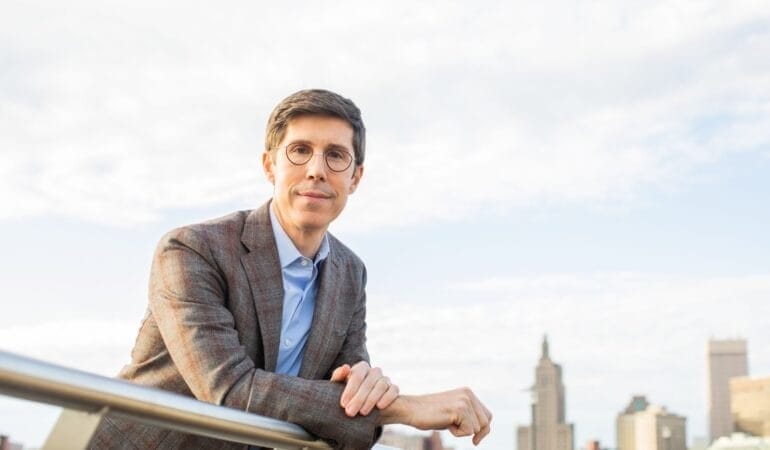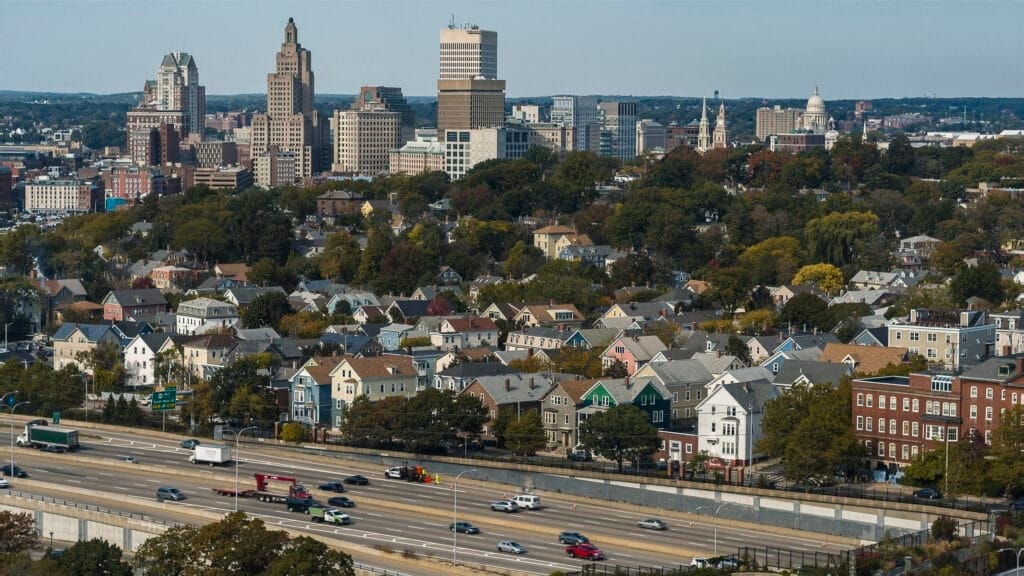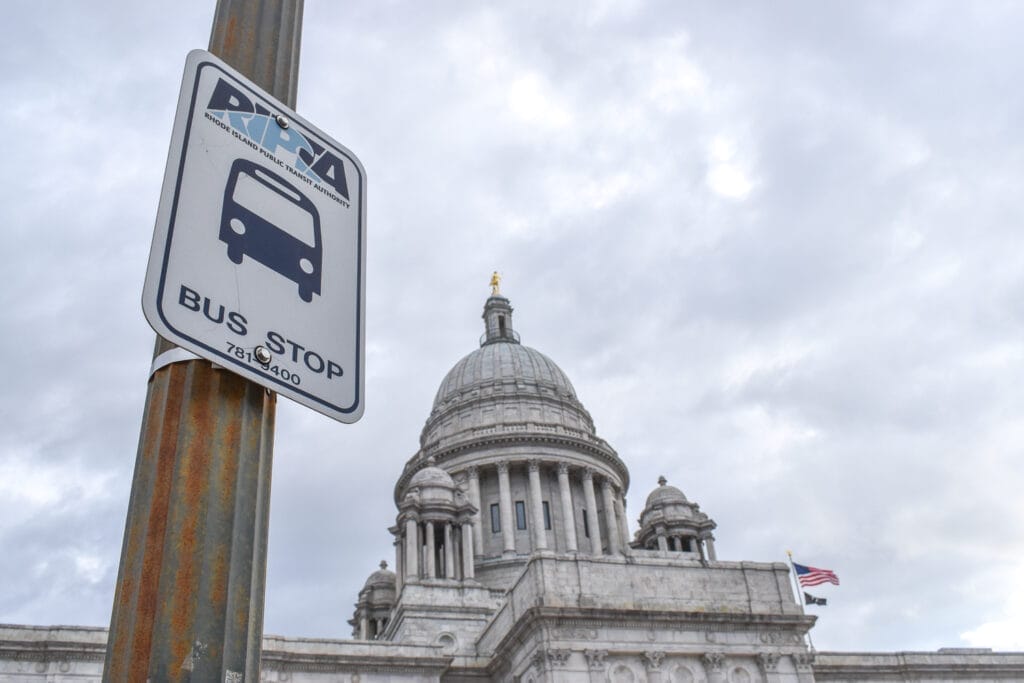
Small City, Big Changes
As the 39th mayor of Providence, Rhode Island, Brett Smiley is addressing public safety, affordable housing, education, and climate resilience. Before being elected mayor in 2022, Smiley—who was born and raised in the Chicago area and moved to Rhode Island to work in politics in 2006—was head of the state Department of Administration, chief operating officer of Providence, and chief of staff for former Rhode Island Governor Gina Raimondo.
With a population of about 191,000, Providence is the third-largest city in New England after Boston and Worcester, Massachusetts. Once home to extensive manufacturing and mills, the city in recent years became known for embracing New Urbanism, historic preservation, and adaptive reuse, and for culinary, cultural, and arts innovations. The Congress for the New Urbanism is returning to Providence in the summer of 2025 for its annual summit.
Smiley sat for an interview with senior fellow Anthony Flint this spring at City Hall. Their conversation, which has been edited for length and clarity, is available as a Land Matters podcast.
Anthony Flint: The narrative arc of Providence over the last 30 years has been remarkable: a second city brought out of economic doldrums by dismantling highways and daylighting rivers and paying attention to urban design. Now there are concerns about affordability, beginning with housing. Where does the city go from here?
Brett Smiley: I appreciate you mentioning the remarkable progress that the city has made. We’ve come a long way, and while many postindustrial cities continue to struggle, Providence is on an entirely different trajectory. Through the pandemic, we had an influx of people wanting urban amenities, wanting arts and culture and diversity and walkability, but with a little bit less work than it is to live in Manhattan or Brooklyn, certainly less expensive than living in those places or in Boston.
One of our competitive points is that we were less expensive. But we’ve not kept pace with building, and as a result, housing prices are skyrocketing. We are on the top five list of net inflow migration, but 50 out of 50 for new housing starts. Our task is to make it easier to build more densely, and to do so in the context of the world in which we find ourselves, so that means incorporating green infrastructure, preparing for climate change, while also allowing for more growth.
We think we can actually lead the way in doing both. It’s an exciting time in the city. We don’t have a hard time selling Providence. What we have a hard time doing is making sure that there’s a home available for everyone who wants one.
AF: You’ve got different places where you can build infill, including surface parking lots. You’ve got some places that don’t require tearing anything down.
BS: We have plenty of places to build. One of our economic challenges has always been that we are in, from a cost perspective, the same economic market as Boston, and yet our rents or sales prices are significantly discounted to Boston. We’ve got a gap to fill there in terms of the price that the housing unit can command and the cost it takes to construct it, which is why we’re working so hard on allowances for things like bonuses for density and the relaxation of parking minimums, ways to try to allow developers to help projects become financially viable; while also looking at some more innovative solutions that cities around the countries are trying, such as changes to the fire code and other ways that actually will reduce the cost of construction by relaxing some of the regulatory requirements.

AF: Unlike the mayors of Boston or Paris, you’ve been a little less enthusiastic about the complete streets concept of pedestrian, bike, and bus lanes. How has your thinking evolved?
BS: I remain convinced that pedestrian safety is of critical importance. We know that one of the reasons that people like living in Providence and want to move to Providence is because of its walkability, and pedestrian safety is super important to me and to the city. We’ve also been working closely with the AARP. Pedestrian safety is really important to older residents. I’m convinced that Providence is a great city to retire to.
The dilemma that I see is that the discussion around bicycle lanes and those who commute by bicycle seems to consume a disproportionate share of the conversation. We know that only two to four percent of the population commutes by bike. We have aspirations of doubling or quadrupling that number. It’s still going to be less than 10 percent of people commuting by bike. We do want to see more people choosing that as an alternate means of transportation. When we’re talking about five percent of the commuting public, sometimes it feels like 75 percent of the conversation.
That’s the shift that I’ve been sensitive to, and I try to devote time and resources to the means and methods of transportation that most people actually use, which is not, in fact, biking. We’re in the Northeast. We have real winters. It’s a city of seven hills, famously in its history, and it doesn’t work for everyone to be able to commute by bike year-round. Most of those folks still have a car. I just try to be realistic about how much time and energy and resources we put into a slice of the commuting public that represents a relatively small minority.
AF: Can you reflect on the challenge of retaining major employers, like the toy manufacturer Hasbro, and the practice of offering things like tax breaks for economic development?
BS: The tactics for economic development have changed in my career in public service. At first, when I was working in government, people were trying to woo headquarters based upon incentives. Then corporate leaders were making decisions, and then the conversation shifted where it became all about talent. Headquarters were choosing where to go based upon where the talent was, maybe less so based upon the financial incentives. Then the pandemic changed it a third time, where with the increase of remote or hybrid work, people are starting to work anywhere and everywhere.
The really meaningful growth that we’ve seen over the last decade, and particularly since the pandemic, are people moving here with good jobs in hand that are located somewhere else or nowhere at all. They’re moving here with good jobs, and it doesn’t matter where their job is. The way in which we think about economic development has shifted. The way I think about economic development has shifted, which is one of the reasons that housing is so primary in my priorities because housing is, in fact, an economic development strategy.
When people can choose where they live and their job is not dependent on that location, you have to give them a high quality of life and an affordable home, and so that’s what we’re working on. Nevertheless, there is still a role for major site-based employers. In terms of municipalities’ reputation, companies that people know can be very important to your identity and to your city’s economic prospects and its brand, if you will, and Hasbro is one of those. It’s got a century-long history in Rhode Island. It’s currently headquartered in neighboring Pawtucket, Rhode Island.
The CEO there has said that that site is no longer working for them, and we found ourselves in a competition with Boston. To date, they’ve not made a decision, but we put forward a very compelling package and proposal, and I hope that they choose Providence. Part of our pitch, in addition to being competitive on an economic package, is again, back to this quality of life and livability. It’s really easy for me to convince the executive suite at Hasbro that mid-career professionals and young workers want to be here, that this is the kind of city that has a youthful vibrancy that other cities have, but it’s a place that they can actually afford to be.
We made a compelling economic package, and we would do that for other major employers as well to choose Providence. I will say, despite the comments about the importance of embracing the hybrid and remote workers, the other thing about having a corporate headquarters that really does matter is it impacts the investments that that company makes in the community, its philanthropy, and its volunteer time. Whereas hybrid or remote workers are often not doing the same level of investment in a community as a headquarters does.
There’s real value in making sure that there is a core corporate community that helps support and sustain our civic institutions, our artistic organizations, and other groups that rely on that corporate philanthropic support that seems to be most generous in the headquarters city as opposed to a regional office or a place in which they just happen to have hybrid or remote workers.
AF: A recent study found that Providence nightlife generates nearly a billion dollars a year in economic activity, but pointed out that many workers can’t catch a bus to go home after the bars and restaurants close. What can Providence, lacking a light rail or subway, do to improve transit?
BS: It’s important that we refer to it as life at night, because it’s not just nightlife. There are thousands of employees that work during what we refer to as “the other nine to five”: 9 p.m. to 5 a.m. That’s restaurants and hospitality and nightclubs, but also someone working the overnight shift at a hospital and other jobs like that.
We don’t have a subway or light rail system here in Providence or anywhere in Rhode Island. We have a bus system that works reasonably well during the day but is less frequent—and in the case of some lines, shuts down—late at night. The solutions are to look at other means of transportation like ridesharing and micromobility, and with our bus system, RIPTA, to provide better service to these major employment centers. We don’t need brand-new innovations. We just need to think about the delivery of services for this other period of time that often gets overlooked and forgotten.

I talk about arts and culture, but nightlife is a big part of it too. This is a fun city, and I think the most thriving nightlife in New England to be sure, with some pretty impressive statistics. On a per capita basis, Providence has more nightclubs than New York City. In terms of percentage of our population, we’re a more diverse city than Los Angeles. There’s something for everyone here and we know for a fact that people come down 95 to go out in Providence from the much bigger neighbor to our north, Boston.
Our reputation as a place of theater, live music, a growing comedy scene, a really vibrant Spanish language club scene, there is really something for everyone here and we want to make sure that not only do people have a safe, fun time, but that that really important contributing part of our economy continues to thrive.
AF: Given the experience of a major bridge having to be closed because of structural integrity issues, what is your vision for investing in infrastructure, particularly now that cities might be looking at a different framework from the federal government?
BS: Part of the story of the Washington Bridge on I-95, which is a major artery here in the city—it’s a state-owned bridge and a Rhode Island DOT-funded project—was inadequate maintenance. The lesson I draw from that is the importance of ongoing maintenance to avoid the much bigger price tag that comes for replacement.
We need to make sure that we’re all taking care of this infrastructure, particularly after four years of significant investment in some real big infrastructure projects here at home and all around the country. Secondly, we need predictable revenue to be able to pay for these projects [such as user fee tolls on heavy trucks]. You can repair it today or replace it tomorrow, and the replacement is always the worse investment.
AF: Similarly, are you worried about the health of the “eds and meds” anchor institutions, which continue to be a critical component of the Providence renaissance, amid the disruptions in federal funding?
BS: I’m very worried about the financial stability of the eds and meds. The change of the indirect cost recovery for NIH grants is affecting Providence already. Both our hospitals and our primary research institution, which is Brown University, depend on those funds. To change the rules of the road midstream is hugely disruptive.
Our largest employers are the hospital and the colleges. It will find its way into our community one way or another with these cuts, whether it’s job losses, depressed real estate values, diminished investment. And all of the good things that might not come as a result of this—the cures to diseases that may not be discovered and solutions to real problems none of us get to benefit from, if the research never happens. It’s a real problem and a real shame. It’s no way to treat really critical partners.
AF: You’re a different kind of politician compared to some past leaders in Rhode Island who might be described as more old-school. How would you rate yourself in terms of engaging with constituents? In a recent interview, you said, “There are times when public leaders need to say, pencils down, we’ve heard enough. This is what we’re doing.”
BS: I think about things in two ways. One is around priorities, and the other is around style. With respect to priorities, I didn’t know him, but the late Boston Mayor Tom Menino talked about being an urban mechanic, [and that] has always been a phrase that resonated with me. I’ve tried to set my priorities on core quality of life issues, things that impact people’s daily lives, and try to make them better. Just try to fix the problems that people actually care about.
I think there’s going to be a huge erosion in trust in government in general. The antidote to that is to show competence and efficiency and effectiveness, particularly at the local level, because our residents know us by name. They’re not shy to tell us what they think isn’t working well. I try to stay focused on those things and not on solving all the world’s problems, but solving a neighborhood’s problems.
In terms of style, I’m a pretty low-key person, and I don’t have high highs, I’m not bombastic, I try to listen to people. We do a lot of community engagement. We’ve tried to do community engagement in some new ways [like Zoom and online surveys]. There does come a moment where the leader just needs to make a decision and move on. That’s what I got elected to do. I’ll be on the ballot again next year. If the voters of Providence don’t like it, they can pick someone else.
I feel like it’s my job to say, “Okay, we’ve heard everyone’s feedback. We’ve made modifications where we think it makes sense. We can agree to disagree on other things. This is what we’re doing moving forward and the day of accountability is election day.” I’m entirely comfortable with that. I think that’s what it takes to get things done. That’s what I think our residents actually want us to do, is to get things done. Inaction is the enemy of progress. It’s something I don’t want to fall victim to.
Anthony Flint is a senior fellow at the Lincoln Institute of Land Policy, host of the Land Matters podcast, and a contributing editor of Land Lines.
Lead image: Mayor Brett Smiley. Credit: City of Providence.
